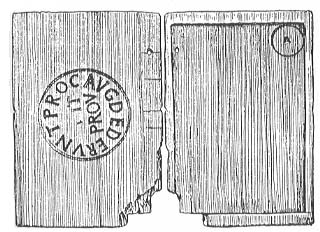
A Corpus of Writing-Tablets from Roman Britain
(A British Academy Research Project)
Project Directors - Dr. A.K. Bowman FBA, Prof. J.M. Brady FRS FEng., Dr. R.S.O. Tomlin FSA, Prof. J.D. Thomas FBA
Research Assistant - Dr J. Pearce

|
A Corpus of Writing-Tablets from Roman Britain(A British Academy Research Project)Project Directors - Dr. A.K. Bowman FBA, Prof. J.M. Brady FRS FEng., Dr. R.S.O. Tomlin FSA, Prof. J.D. Thomas FBA Research Assistant - Dr J. Pearce |
'We write in connection with a project based at the Centre for the Study of Ancient Documents (CSAD), the aim of which is to compile a corpus of Romano-British writing tablets. The Centre brings together scholars from Oxford and other universities with expertise in languages and documents from the Graeco-Roman world and is developing new techniques of image enhancement in order to improve the reading of ancient documents. Among the projects undertaken related to Britain are the publication of the wooden writing tablets from the forts of Vindolanda and Carlisle and the lead 'curse tablets' from temples at Bath and Uley. Although these represent by far the largest groups of such texts, similar documents have been recovered in smaller numbers from many locations and their discovery can be anticipated in future excavations. Wooden ink and stylus tablets for example are known from the fortress at Caerleon, many parts of Roman London and rural sites at Chew Stoke (Somerset), Stonea (Cambridgeshire) and Wavendon Gate (Buckinghamshire). Lead curse tablets and other 'magical' texts' on metal have been recorded from temple sites, from towns, including London and Silchester, the amphitheatre at Caerleon, rural sites, for example West Deeping (Lincolnshire), and occasionally from urban and rural cemeteries, for example St Albans and Wasperton (Warwickshire). The use of metal detectors in particular is bringing an increasing number of lead tablets to light. The contents of both these types of document shed fascinating new light on Romano-British society and their discovery makes Britain the most important source of new Vulgar Latin texts in the Roman world (a list of relevant publications is provided).
Given the potentially wide distribution of such documents, including single finds which may lie undetected in older collections, we are seeking as part of this British Academy project to compile a corpus of Romano-British writing tablets. This will include the larger bodies of documents, smaller groups and individual texts. In the preparatory work for this project our aim is twofold:
We are writing therefore to ask for your assistance in compiling this corpus. If the collections under your management include such material we would be very grateful if you could supply us with the following information:
An additional reason for compiling a corpus of writing tablets is that they have been mostly excluded from the Roman Inscriptions of Britain (RIB) volumes. Please note that we are therefore excluding from our survey inscriptions on stone (RIB I)and most of the categories of artefacts bearing writing which are catalogued in the fascicules of RIB II . However we are interested to hear of discoveries of these for inclusion in the annual accounts of work on Roman Britain in the journal Britannia. These types of artefacts include, for example, military diplomas, graffiti, painted inscriptions and stamps on amphorae and other ceramics and tiles, metal artefacts bearing writing, whether cast, stamped, incised or punched, relating to production, supply, ownership, or religious dedication.
We thank you in advance for any help you provide and ask you not to hesitate to contact us if you require further information. We will of course not proceed with publication of texts in the corpus in any form without prior consultation with you regarding copyright.'
(Copies of this document were distributed to museums and archaeological units in the winter of 1999-2000)
CSAD | Introduction | Letter to museums | Description of curse tablets | Progress report | Images and references